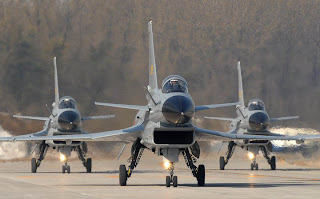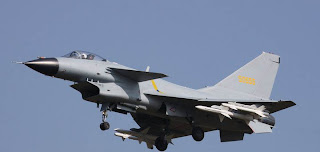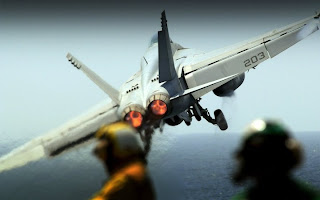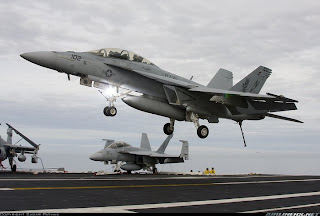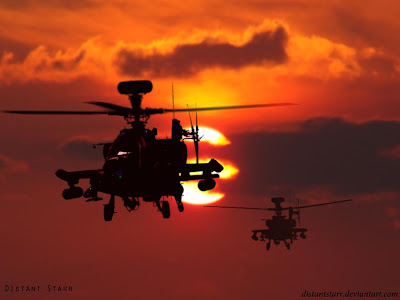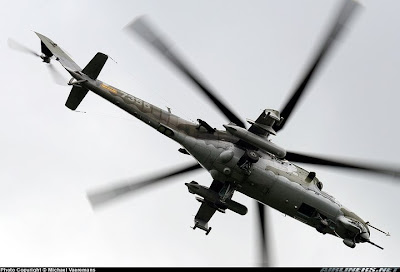By the Sukhoi Design Bureau, the Su-34 will replace the Su-24 Fencer frontline bombers. Sukhoi says the new bomber has the potential to become the best plane in its class for years to come. In Russia one Su-34 costs about one billion rubles. The $36 million Su-34 fighter-bomber is a two-seat strike aircraft equipped with twin AL-31MF afterburning turbojet engines. It is designed to deliver high-precision strikes on heavily defended targets in any weather conditions, day or night, and fields weaponry that includes a 30mm GSh-301 cannon, up to 12 Alamo or Archer AAMs, ASMs, and bombs.

The Su-32/34 will be one of the three high performance aircraft that are planned to form the core of the future Russian Air Force, along with the Yak-130 advanced trainer and a new multi-functional fighter (PAK-FA). The Strike Flanker was in competition with the Su-30 to replace the Su-24 and was successful due to the potential of growth of the avionics, since it had twice the space in relation to the other airplanes of the Flanker family.
Su-34 (Su-27IB - Istrebitel-Bombardirovshchik) is a two seat ("arm-to-arm") strike variant that first flew in 1990. It features frontal wings and a large flattened nose with sharp edges (like the SR-71) reduce radar cross-section. This new ship-borne fighter is fitted with two AL-31FP engines with vectored thrust. Using them allows either the take-off distance or maximum take-off weight (MTOW) of the aircraft to be increased by 10-15 per cent. In the nose is a new multi-mode phased-array radar with terrain-following and terrain-avoidance for low-level attack. The aircraft has a distinctive large "sting" in the rear which contains the NO-14 radiolocation system, a radioelectronic countermeasures system, and a fuel tank. The NIIP NO-12 rearward radar that monitors enemy fighter activity behind the aircraft, and as needed, direct R-73 short-range and R-77 medium-range
The two members of the crew sit down side by side in a large cabin, with the pilot-commander to the left and navigator/operator of weapons to the right in a jettisonable Zvezda K-36dm seat [that has an inlaid system of massage]. The advantage of the side by side cockpit is not to need to duplicate instruments and controls of flight, which improves efficiency and comfort. As long missions require comfort, it has pressurization that it allows to operate up to 10,000 meters without oxygen masks, which are available for emergencies and combat situations. The members of the crew can leave the seats and be in vertical position and relax. The space between the seats allows that they can lie down in the corridor, if necessary.
A long-range surveillance radar, passive detection systems, system of communication for tactical and strategical voice and data in a single platform with long-range capacity with flight refuelling, transform it into a way of monitoring and recognition in real time and platform of command and control, forming a complete battle management system.
Su-34 Fullback Program History
The first aircraft was a Su-27UB, which featured a frontal section with new radar, bigger and widened nose. The new variant was called Su-27IB initially (Istrebityel-bombardirovshchik - fighter aircraft). The new section of the nose had a side by side cockpit. The leading edges were extended until the root of the cabin and had canards. The first prototype was not equipped with fire control systems and was used for aerodynamic tests and arrangement of cockpit. It had an improvement in the maneuverability and characteristics of landing and take-off. The air inlet lost variable geometry, since high speed at great altitude was not as important, as the bomber works most of the time at cruise speed or at low altitude.
The Su-27IB (T-10v for the Sukhoi) flew for the first time on 13 April 1990, piloted by Anatoly Ivanov and as the prototype, already called Su-34, it flew on 18 December of 1993. At this time, the development was transferred to the Novosibirsk Aircraft Production Assoc (NAPO) manufacturer in Novosibirsk in Siberia for the base of tests of the Russian Air Force in Zhukovsky. The development was decelerated in 1997 for the Sukhoi to concentrate itself in the development of the Indian Su-30 and the Su-27 acquired by China. The Su-34 was successfully tested in the Chechenya according to Russian authorities, and also it participated of exercises of combat in the military field of Ashuluk in 1999.
It will be the new Russian theater strike aircraft, substituting initially for the Su-24 Fencer (the Russian equivalent of the F-111). By the year 2000 the Russian Air Force had a total of 445 Fencer in Russia, being 365 in the version, B, C, and D and 80 Su-24MR and MP for reconnaisance and Electronic War. Later it will substitute the Su-17 and the Mig-27 in the tactical attack aviation. Also it is planned to be the new Russian naval bomber with coastal base, substituting the naval versions of the 95 Fencer Su-24MF (70 Su-24/Su-24M and 25 Su-24MR/MP) and of the naval Su-17 Fitters and later Tu-22 in attack antiship and Tu-142 in anti-submarine war.
On 15 December 2006 Russia's Air Force received its first two newly built Su-34 Fullback bombers. A ceremonial handover of the Su-34s took place at the Chkalov Aircraft Production Association in Novosibirsk, in West Siberia. In attendance were Russia's Air Force commander, Army General Vladimir Mikhailov, and Sukhoi holding Director General Mikhail Pogosyan. Though the newly launched Su-34s were marked 01 and 02, they were in fact the latest in a test series of 10 aircraft. Others had been withdrawn by the designer as a basis for further upgrades. The current version had gone through three major upgrades: in 1999, 2004, and earlier in 2006. Mikhailov said Russia's Air Force needs about 200 Su-34s, which will be on active duty in the next 30-40 years along with modernized Su-24s, which are expected to be gradually replaced over the next 20 years. "In all, we need about 200 [Su-34] aircraft," he said, "But at the same time, we do not want to replace the modernized Su-24[M] in the next two or three years, as the aircraft can be in service for 10-15 years. All of the Su-24s will be replaced with Su-34s in around 20 years."
The commander said the Su-34 has been modernized twice since the late 1980s, when it was designed, and will be further modernized after 10 years in service. Defense Minister Sergei Ivanov said earlier that Russia's Air Force will buy 58 Su-34s by 2015. Deputy Prime Minister, Defense Minister Sergei Ivanov said Russia's Defense Ministry will purchase a regiment of 24 newest Su-34 planes for the Air Force by 2010. "Everything has been coordinated and decided upon in a short-term perspective. The Defense Ministry was granted the right from 2004 to conclude long-term three-year contacts with defense companies. As a result, two batch-production Su-34 planes will be purchased in 2006, six in 2007, ten in 2008, with purchases increasing in coming years. Therefore, we have to buy a whole regiment of 24 Su-34 planes in 2010," the deputy prime minister said.
The Su-32 and Su-34 have been developed and were in serial production in Novosibirsk Aircraft Production Assoc (NAPO) for the Russian Ministry of Defence. As of December 2006 it was estimated that by the middle of the next decade the plant will produce as many as 70 fuselage kits for SuperJet and ten Su-34s annually (with provision for 20 Su-34s in case of necessity). Export potential is estimated at between 100 and 200 aircraft. The Su-34 fighter-bomber is intended to replace Russian Su-17, Su-24, and the MiG-27. A reconnaissance variant will replace the Su-24MR in the tactical reconnaissance and EW role.
The Su-34 will replace the Su-24M aircraft (about 400 planes), the Su-24MR surveillance aircraft (over 100 planes), and the MiG-25RB aircraft (about 70). Russia will have to produce between 550 and 600 Su-34s to replace these obsolete aircraft within 10-15 years. However, the Defense Ministry plans to buy only about 58 such planes by 2015, and a total of 300 by 2022. Many experts say that if the Su-24 and MiG-25RB aircraft are scrapped by 2020, Russia will be left without fighter-bombers and surveillance aircraft. Others argue that this number will be enough for the Air Force's new concept.






